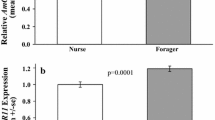Abstract
Pheromones produce dramatic behavioral and physiological responses in a wide variety of species. Releaser pheromones elicit rapid responses within seconds or minutes, while primer pheromones produce long-term changes which may take days to manifest. Honeybee queen mandibular pheromone (QMP) elicits multiple distinct behavioral and physiological responses in worker bees, as both a releaser and primer, and thus produces responses on vastly different time scales. In this study, we demonstrate that releaser and primer responses to QMP can be uncoupled. First, treatment with the juvenile hormone analog methoprene leaves a releaser response (attraction to QMP) intact, but modulates QMP’s primer effects on sucrose responsiveness. Secondly, two components of QMP (9-ODA and 9-HDA) do not elicit a releaser response (attraction) but are as effective as QMP at modulating a primer response, downregulation of foraging-related brain gene expression. These results suggest that different responses to a single pheromone may be produced via distinct pathways.

Similar content being viewed by others
References
Anton S, Gadenne C (1999) Effect of juvenile hormone on the central nervous processing of sex pheromone in an insect. Proc Natl Acad Sci USA 96(10): 5764–5767
Barron AB, Robinson GE (2005) Selective modulation of task performance by octopamine in honey bee (Apis mellifera) division of labour. J Comp Physiol A Sens Neural Behav Physiol 191(7):659–668
Grozinger CM, Robinson GE (2006) Methoprene blocks inhibition of Kruppel-homolog 1 gene expression by honey bee queen mandibular pheromone. J Comp Physiol [A] (in press)
Grozinger CM, Sharabash NM, Whitfield CW, Robinson GE (2003) Pheromone-mediated gene expression in the honey bee brain. Proc Natl Acad Sci USA 100 Suppl 2: 14519–14525
Keeling CI, Slessor KN, Higo HA, Winston ML (2003) New components of the honey bee (Apis mellifera L.) queen retinue pheromone. Proc Natl Acad Sci USA 100(8):4486–4491
Pankiw T, Page RE Jr (2003) Effect of pheromones, hormones, and handling on sucrose response thresholds of honey bees (Apis mellifera L.). J Comp Physiol A Sens Neural Behav Physiol 189(9):675–684
Pankiw T, Huang Z, Winston ML, Robinson GE (1998) Queen mandibular gland pheromone influences worker honey bee (Apis mellifera L.) foraging ontogeny and juvenile hormone titers. J Insect Physiol 44(7–8):685–692
Pham-Delegue MH, Trouiller J, Caillaud CM, Roger B, Masson C (1993) Effect of queen pheromone on worker bees of different ages: behavioural and eletrophysiological responses. Apidologie 24:267–281
Robinson GE (1987) Modulation of alarm pheromone perception in the honey bee: evidence for division of labor based on homonally regulated response thresholds. J Comp Physiol 160:613–619
Schulz DJ, Sullivan JP, Robinson GE (2002) Juvenile hormone and octopamine in the regulation of division of labor in honey bee colonies. Horm Behav 42(2):222–231
Slessor KN, Winston ML, Le Conte Y (2005) Pheromone communication in the honeybee (Apis mellifera L.). J Chem Ecol 31(11):2731–2745
Vargo EL, Hulsey CD (2000) Multiple glandular origins of queen pheromones in the fire ant Solenopsis invicta. J Insect Physiol 46(8):1151–1159
Whitfield CW, Cziko AM, Robinson GE (2003) Gene expression profiles in the brain predict behavior in individual honey bees. Science 302(5643):296–299
Acknowledgements
We would like to thank Josh Summers and Jennifer Keller for expert beekeeping assistance, Cavell Brownie for statistical advice, and Gene Robinson, Robert Anholt, and Fred Gould for critical reading of the manuscript, and anonymous reviewers for helpful comments. This work was supported by an NIH-NIDCD grant (1 R01 DC006395-01A1) to G.E. Robinson (subaward to CMG), and an NCSU URA to PF. This experiment complies with the laws of the USA.
Author information
Authors and Affiliations
Corresponding author
Rights and permissions
About this article
Cite this article
Grozinger, C.M., Fischer, P. & Hampton, J.E. Uncoupling primer and releaser responses to pheromone in honey bees. Naturwissenschaften 94, 375–379 (2007). https://doi.org/10.1007/s00114-006-0197-8
Received:
Revised:
Accepted:
Published:
Issue Date:
DOI: https://doi.org/10.1007/s00114-006-0197-8




